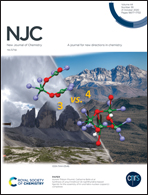H5PV2Mo10O40 encapsulated into Cu3(BTC)2 as an efficient heterogeneous nanocrystalline catalyst for styrene epoxidation†
Abstract
The Keggin-type polyoxometalate H5PV2Mo10O40 (HPMoV) was encapsulated into the Cu3(BTC)2 framework (H3BTC = 1,3,5-benzenetricarboxylic acid) via a liquid-assisted grinding (LAG) method to obtain nanocrystalline POM@MOF, i.e. NENU-9N, formulated as [Cu12(BTC)8(H2O)12][H5PV2Mo10O40]. The NENU-9N was characterized by powder X-ray diffraction (XRD), Fourier transform infrared (FT-IR) spectroscopy, scanning electron microscopy (SEM), thermal gravimetric analysis (TGA) and nitrogen adsorption–desorption analysis, indicating that NENU-9N has good crystallinity, excellent thermal stability, permanent porosity, and uniform particle size (about 70 nm). The catalytic performance of NENU-9N as a heterogeneous catalyst for the epoxidation of styrene using oxygen as the oxidant was studied. As a result, NENU-9N showed excellent catalytic performance (97.2% styrene conversion with 93.5% selectivity to styrene oxide) which can be attributed to the synergistic catalysis between Cu3(BTC)2 and HPMoV. The nanocrystalline catalyst had good stability and recyclability which can be recycled at least 5 times with no significant loss of catalytic activity. Furthermore, the catalytic mechanism of NENU-9N on the aerobic epoxidation of styrene was investigated by radical quenching experiments.



 Please wait while we load your content...
Please wait while we load your content...